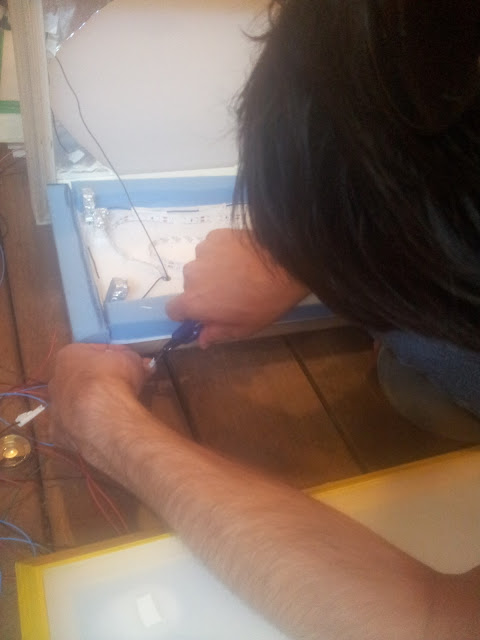1.1
Objective
1.1.1
The Street Simon
Prototype will enable a short and fun interaction with the game for a single
user.
1.1.2
The Street Simon
Prototype will enable a short and fun interaction with the game for multiple
users, both on the same side of the sidewalk, and on opposing sides of the
sidewalk (henceforth known as Side A and Side B).
1.1.3
The Street Simon
Prototype aims to pass the time for pedestrians waiting for the traffic light
to change, and so the game will only be active while the pedestrian traffic
light is red.
1.2
General Physical
Requirements
1.2.1
8 life sized
switches (4 for each interface)- 2 red, 2 yellow, 2 green and 2 blue
1.2.2
An analogue screen
for the score board
1.3
Additional Notes
1.3.1
The game patterns will be composed of 4 visual
and audio elements- element A (blue light, sound 1), element B (Red light,
sound 2), element C (Green light, sound 3), element D (yellow light, sound 4).
1.3.2
“Single Player” mode
refers to a game where only one of the sides is playing (either side A or side
B). On one of the sides, there could be a number of players playing together,
however the game will not differentiate between many players on one side and
one player on that same side.
1.3.3
“Multiple Players”
mode refers to a game where both Sides A and Sides B are playing
simultaneously.
1.4
Synchronization with
Pedestrian Traffic Lights
1.4.1
The timing program
of the relevant pedestrian traffic light (for which the game will be placed)
will be measured before placement of the game.
1.4.2
The game will be
active at all times when the pedestrian traffic light is red.
1.4.3
The game will be
inactive when the pedestrian traffic light is green.
2.1
Objective
2.1.1
The User will be able
to instinctively understand how the game works.
2.1.2
The system will be
able to identify the type of game (single player or multiplayer).
2.2
Commencing the Game
2.2.1
The initial game
sequence will commence once the user steps on the “Pad” which presents a
drawing of footprints and is accompanied by the text “Stand here to begin
Playing”.
2.2.2
The initial game
sequence will include a short sequence of all the 4 elements in a pattern, and
will indicate the beginning of the game to the user.
2.2.3
If the system
identifies a player on both Side A and Side B, the game will act as a
multiplayer game.
2.2.4
If the system
identifies a player only on one side of the game (either Side A or Side B), that
game will act as a single player game.
3.1
Objective
3.1.1
The user/users on a
single side will be required to repeat patterns.
3.2
Interaction
3.2.1
The user/users on a
single side will be required to repeat patterns.
3.2.2
Each pattern
completed is equal to one level.
3.2.3
The patterns
increase by the addition of a single element as each level increases.
3.2.4
Each time the user
completes a pattern, the completion sounds will be played.
3.2.5
If the user steps on
the wrong key (for example the pattern provided was red-blue-green and he
pressed red-green), this means he has failed the game, and the “game failed”
sound will be played
3.3
Restarting the Game
3.3.1
If no keys are
pressed during the game for 15 seconds, the game will restart.
3.3.2
If the user has
failed the game, the game will restart.
3.3.3
If the pedestrian
traffic light turns green, the game will restart but be inactive until the
traffic light is red once again.
3.4
Score
3.4.1
A counter screen
displaying the word “score” and increasing digits will be created.
3.4.2
Each completion of a
pattern rewards the player with one point.
3.4.3
The scoreboard will reset to 0 every time the game “restarts”.
4.1
Objective
3.4.1
The user/users on a both
sides of the crosswalk will be required to repeat patterns and compete against
each other.
4.2
Interaction
4.2.1
Both interfaces on
side A and side B will carry on autonomously and accordingly to the
requirements made in section 3.2 and 3.3.
4.3
Score
4.3.1
The only addition
made in multiplayer mode refers to the scoreboard.
4.3.2
Once the system
identifies a multiplayer game, the scoreboard will consist of “Your Side” and
the increasing score (referring to the score of that specific Simon interface),
and “The Other Side”, which will show the increasing score of the player on the
other side of the crosswalk.
4.3.3
Once the game ends,
either by one of the players ceasing to play, or by the traffic light changing
to green, the scoreboard on the side with most points in that session will
present the text “You Win!”. The score board on the losing side will present
the text “The Other Side Wins”.
4.3.4
If one of the sides
“fails the game”, the other side will be declared winner and the failing side
will be presented with the text “The Other Side Wins”.



































.jpg)



